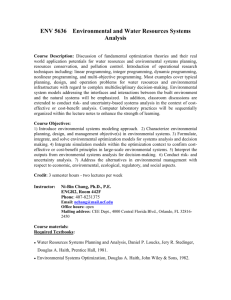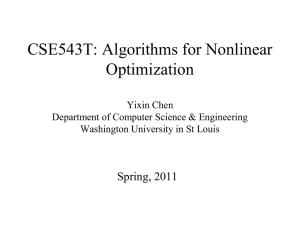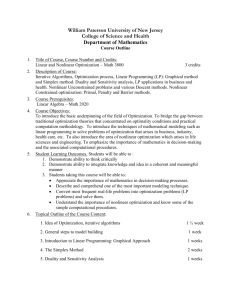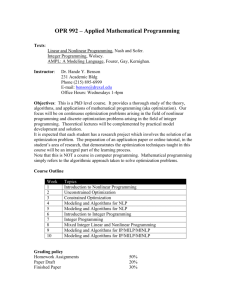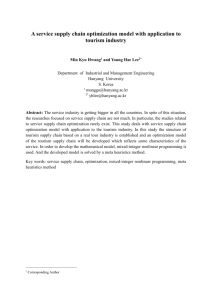What is an Optimization Problem?
advertisement
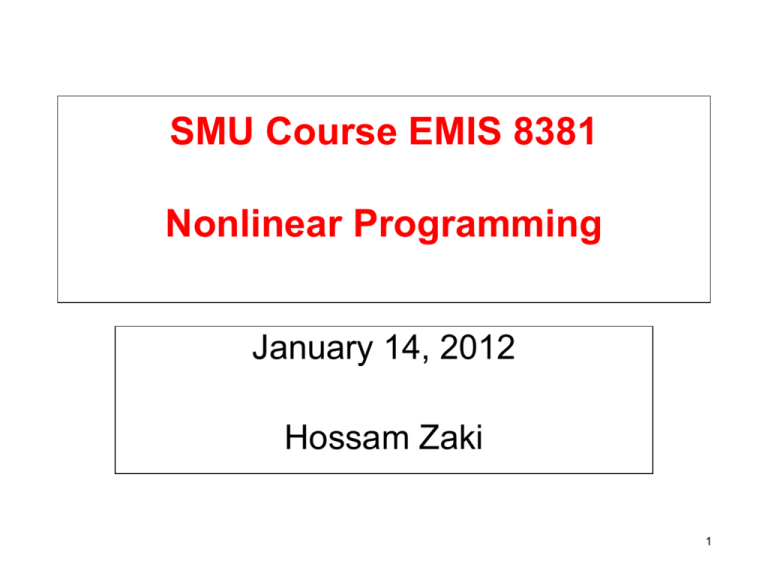
SMU Course EMIS 8381 Nonlinear Programming January 14, 2012 Hossam Zaki 1 Outline • Introductions – 5 minutes each • Course Scope – What is an optimization problem? – Examplea – Classification of Optimization Problems • Course Syllabus – Description & Pre requisites – Text & References – Calendar &Grading • On Line Resources • Course Topics • Course Context – DSS Example & Paradigm – Career Roles & Questions 2 Scope 3 What is an Optimization Problem? • Optimization problems involve the selection of values of a number of interrelated variables in such a way to optimize on one or more selection criteria designed to measure the quality of each selection 4 Example: Price Optimization • A distributor sells 100K products to 20K customers needs to determine every month the set of prices that will maximize margin while satisfying product and customer pricing rules such as – GbB (Good, better, Best), – PGS (Platinum, Gold, Silver) • Sources of nonlinearity – Margin = (price – cost) * quantity – Quantity = a – b * price 5 High Level Price Optimization Volume Market Response Model V* Price Margin $ MG* Price Optimizer Price Increase Zone Price Decrease Zone Pm* Price 6 Example: Portfolio Optimization • Markowitz Model – Given stocks returns and covariances, find a minimum variance portfolio that will generate a pre specified average return. That is, determine how much to invest in each stock to minimize risk at a certain level of return – Sources of nonlinearity • Risk = w(i) * w(j) * cov(i,j) 7 Example: Regression • Given N(1000) observations, find the values of the (linear or nonlinear) model parameters that will minimize the distance between model and observed • Sources of nonlinearity – Minimum [ Y (mode) – Y (observed)]2 – Y (model ) = a0 + sum ( aj * xj) 8 Optimization Problem Statement • Select the values of a vector x in Rn • From a set of feasible vectors X in Rn – that satisfy a group of algebraic constraints • In such a way that will optimize the value of a real-valued function f(x) 9 Terminology • Decision Variables = x • Objective Function(s) = f(x) • Feasible Region = X – Constraints defining X • Inequality constraints : g(x)<=0 • Equality constraints : h(x)=0 10 Optimization Problems Three Classifiers Decision Variables Optimization Problems Constraints Objective 11 DV Attributes Continuous Sequential Discrete DV Infinite Dims Finite Dims 12 Objective Attributes One Non Linear Linear Many Objective Non Differentiable From Simulation Closed form Differentiable 13 Constraints Attributes Un Constrained Stochastic Linear Simple Bounds Deterministic Constraints GUB Nonlinear Block Diagonal Network 14 Optimization Problems Finite DV Continuous DV Decision Variables (DV) • Discrete • Continuous • Finite • Infinite Objective • One One Obj • Many Differentiable• Obj Differentiable Deterministic• Obj Non Differentiable • Closed Form • From Simulation • Linear • Non linear • Deterministic • Stochastic Constraints Unconstrained • Unconstrained Linear Constraints • Constrained • Linear • Non linear • Simple bounds • GUB • Network • Block diagonal 15 © 2006, 2007 Zilliant, Inc. -- CONFIDENTIAL Course Scope • Decision Variable – Continuous – Finite dimensions • Objective – – – – Single Closed form or From Simulation Linear or Nonlinear Deterministic • Constraints – Deterministic 16 Exercise # 1 • Identify the attributes that define the following optimization problems and provide one simple example. Display the results in table format 1. 2. 3. 4. 5. Linear Programming Goal Programming Network Programming Integer Programming Non differentiable Optimization 6. Global Optimization 7. Dynamic Programming 8. Stochastic Programming 9. Quadratic Programming 10. Fractional Programming 11. Geometric Programming 12. Multi Objective Optimization 17 Course Syllabus 18 Course Description • This course discusses, presents and explains the most important methods and results used to model and solve nonlinear optimization problems. 19 Prerequisites • Advanced calculus (partial derivatives) • Linear algebra (vectors and matrices). • Knowledge on linear programming is helpful but not required (we will cover what we need). 20 Text & References • Text Book – "Nonlinear Programming: Theory and Algorithms" by, M. Bazaraa, H. Sherali and C Shetty, 3rd Edition, John Wiley, ISBN • References – “Handbooks in OR & MS, Volume 1, Optimization”, Nemhauser et al editors, North Holand, Chapters I and III, 1989 – Dennis & Schnabel, “Numerical Methods for Unconstrained Optimization”, Prentice-Hall, 1983 – Gill, Murray and Wright, “Practical Optimization”, Academic Press, 1981 – D. Luenberger, “Linear and Nonlinear Programming”, 2nd Edition, Addison Wesely, 1984 – D. Bertsekas, “Nonlinear Programming”, 2nd Edition, Athena Scientific, 1999 21 Class Calendar • Class (Section001) – Saturday 9 AM-11:50 PM • 10 Minute break every 50 minutes – Meets in 205 Junkins • 14 Class Periods – First Class Period: January 14 • No Class: 3/10 (SB) & 4/7 (GF is on 4/6) – Last Class Period: April 28 22 Grading • In-class Exams (70%) – Mid Term on 3/2 = (30%) – Final on 4/28 = (40%) • Term Paper & Presentation (20%) – A nonlinear optimization topic, e.g. algorithm, application and /or software demo not covered in class – Due on 3/31 • Homework (10%) 23 On Line Resources 24 Mathematical Programming Glossary http://glossary.computing.society.informs.org/index.php?page=N.html • General Information - A list of dictionaries, suggested methods of citation, and contribution instructions. • The Nature of Mathematical Programming - See this for basic terms and a standard form of a mathematical program that is used throughout this glossary. • Notation - Read this to clarify notation. • Supplements - A list of supplements that are cited by entries. • Myths and Counter Examples - Some common and uncommon misconceptions. • Tours - Collections of Glossary entries for a particular subject. • Biographies - Some notes on famous mathematicians. • Please remember this is a glossary, not a survey, so no attempt is made to cite credits. 25 1998 Nonlinear Programming Software Survey • http://www.lionhrtpub.com/orms/surveys/nlp/nlp. html • The information in this survey was provided by the vendors in response to a questionnaire developed by Stephen Nash. The survey should not be considered as comprehensive, but rather as a representation of available NLP packages. The listings are limited to products that fit the parameters of the survey as outlined in the accompanying article. 26 Nonlinear Programming Frequently Asked Questions http://wwwunix.mcs.anl.gov/otc/Guide/faq/nonlinearprogramming-faq.html • Q1. "What is Nonlinear Programming?" • Q2. "What software is there for nonlinear optimization?" • Q4. "What references are there in this field?" • Q5. "What's available online in this field?" 27 NEOS Guide http://www-fp.mcs.anl.gov/OTC/Guide/ • The Optimization Tree. Our thumbnail sketch of optimization (also known as numerical optimization or mathematical programming) and its various sub disciplines. • The Optimization Software Guide. Information on software packages from the book by Moré and Wright, updated for the NEOS Guide. • Frequently Asked Questions on Linear and Nonlinear Programming. These are the FAQs initiated by John Gregory, now maintained by Bob Fourer as part of the NEOS Guide. 28 MIT Nonlinear Course • Prof. Dimitri Bertsekas http://ocw.mit.edu/OcwWeb/ElectricalEngineering-and-Computer-Science/6252JNon-linearProgrammingSpring2003/CourseHome/ 29 UCLA Nonlinear EE Course • Prof. Lieven Vandenberghe http://www.ee.ucla.edu/ee236b/ 30 Course Topics 31 Course Topics • Chapter 1 – Intro • Appendix A – Math Review • Chapter 2 – Convex Sets • Chapter 3 – Convex Functions • Chapter 4 • Chapter 6 – Lagragian Duality • Chapter 8 – Unconstrained Opt • Chapter 9 – Penalty and Barrier • Chapter 10 – Methods of Feasible Directions – Optimality Conditions 32 Exercise # 2 Plot and solve graphically: Maximize x1 Subject to h1(x1,x2) = x12 – x2 + a = 0 h2(x1,x2) = – x1 + x22 + a = 0 For the following values of a: a = 1, 0.25, 0 and -1 33 Course Context 34 DSS Example Cost of new Resources Aggregate Demand Profile Timing Constraints Optimization Model Business Rules Capacity Configuration Alternative Resources Existing Capacity Feedback Stochastic Daily Demand Stochastic Show-up rates Simulation Model Daily Resources Stochastic Success Rates What if Operations Characteristics 35 Decision Support System Development Methodology 12. Estimate Lift (Improvement) 1. Understand Business Context and Formulate Problem Statement in English 11. Perform What-if 2. Develop DSS High Level Design 10. Prepare & analyze output. Validate results 9. Solve Real Problems 3. Formulate Mathematical Model DV, Objective, Constraints, Goals ITERATE 4. Receive, Clean and Synthesize Business Data. Create DB 8. Refine Formulation: Aggregate, Decompose, Transform 5. Estimate and/or Forecast needed data, e.g. demand 7. Prepare & Solve Small Sample Problems 6. Develop or Select Solver, prepare input files, connect to DB DV = Decision Variable DB = Database 36 How will the course help u with career questions? Which problems to invest $ in? What is the expected lift? Develop in house or buy? Service or license? How to gain tech diff over competitors? P Should we productize? SVP How many scientists do we need? VP Director What is the impact of a data change? How to validate results? Reformulate? How to formulate? Senior Manager Manager Senior Scientist Scientist, OR Specialist, Consultant How many person-months? How to prioritize tasks? Which solver to use? Which parameters? Which algorithm? 37 Questions? 38


